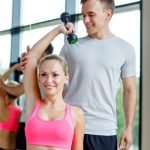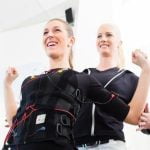Functional fitness has gained popularity in recent years as a versatile and effective approach to exercise. But what exactly is functional fitness? In this introductory section, we will explore the definition and explanation of functional fitness exercises, as well as the importance and benefits of incorporating them into your workout routine.
Functional fitness can be defined as a method of training that focuses on movements and exercises that mimic daily activities we commonly perform. The goal is to improve strength, flexibility, endurance, balance, and coordination to enhance our ability to carry out everyday tasks with ease. Unlike traditional workouts that often isolate specific muscles or body parts, functional fitness exercises engage multiple muscle groups simultaneously.
Incorporating functional fitness into your workout routine offers numerous benefits. Aside from increasing overall strength and conditioning, it also improves posture, stability, and joint mobility. Additionally, functional fitness helps develop core strength and enhances our ability to move efficiently in all planes of motion. Whether you’re an athlete looking to enhance performance or someone wanting to function better in daily life, functional fitness can be a valuable addition to your training regimen.
Now that we have a general understanding of what functional fitness is and its advantages let’s delve deeper into the core principles behind these exercises in the next section. Understanding these principles will shed light on how functional fitness differs from traditional workouts and give us insights into examples of functional movements and exercises.
Understanding the Core Principles of Functional Fitness
Functional fitness is more than just a trendy workout; it is a training approach that focuses on movements that mimic real-life activities. The core principles of functional fitness involve targeting multiple muscle groups, improving balance and stability, and enhancing flexibility and mobility. Unlike traditional workouts that isolate specific muscles or body parts, functional fitness exercises aim to improve overall functionality and performance in daily life.
One of the key principles behind functional fitness is the emphasis on multi-joint movements and compound exercises. This means that instead of isolating a single muscle group, functional exercises engage multiple joints and muscles simultaneously. For example, a squat exercise not only works the quadriceps but also engages the glutes, hamstrings, and core muscles. This holistic approach to training allows individuals to build strength and power while improving coordination and balance.
Functional fitness exercises can take various forms and incorporate a wide range of movements. Some common examples include lunges, step-ups, kettlebell swings, medicine ball throws, and TRX exercises. These movements are designed to simulate real-life actions such as pushing, pulling, carrying, lifting, and twisting. By practicing these functional movements in our workouts, we can enhance our ability to perform everyday tasks more efficiently and reduce the risk of injury.
Functional Fitness Exercises for Strength and Power
Functional fitness exercises are a great way to build strength and power in your workouts. These kinds of exercises focus on multi-joint movements and compound exercises that engage multiple muscle groups at once, making them incredibly effective for increasing overall strength and power.
One example of a functional fitness exercise for strength and power is squats. Squats are a compound exercise that targets the muscles in your lower body, including your quadriceps, hamstrings, and glutes.
This exercise not only helps to build leg strength but also engages your core for stability and balance. To perform a squat, stand with your feet shoulder-width apart, lower yourself down into a sitting position as if you were sitting back into a chair, then push through your heels to return to standing.
Another functional exercise for strength is the deadlift. Deadlifts target the muscles in your back, glutes, hamstrings, and legs.
They are an excellent exercise for building overall body strength because they involve lifting a heavy weight from the ground up to hip level using proper form and technique. To perform a deadlift, stand with your feet shoulder-width apart, hinge forward at the hips while keeping your spine straight and lift the weight up by driving through your heels until you are fully standing.
Kettlebell swings are yet another fantastic functional fitness exercise that can help improve both strength and power. This exercise primarily targets the muscles in your posterior chain – including your glutes, hamstrings, and lower back – while also engaging muscles in your core, shoulders, and arms.
To perform a kettlebell swing, stand with your feet shoulder-width apart while holding onto the kettlebell handle with both hands. Swing the kettlebell between your legs by hinging at the hips before powerfully thrusting it forward using momentum from your hips and glutes until it reaches chest height.
Incorporating functional fitness exercises like squats, deadlifts, and kettlebell swings into your workout routine can help you build strength and power in a functional and practical way, making it easier to perform everyday tasks and improve athletic performance.
Functional Fitness Exercises for Balance and Stability
Balance and stability are crucial components of functional fitness. By improving these aspects, individuals can enhance their overall performance in daily activities and reduce the risk of injury. Functional fitness exercises that target balance and stability involve engaging the muscles throughout the body to maintain proper alignment and coordination. These exercises often challenge the core muscles, as they play a significant role in maintaining balance.
One exercise that focuses on improving balance and stability is lunges. Lunges target the lower body, particularly the quadriceps, hamstrings, and glutes. Performing lunges requires individuals to stabilize their bodies while stepping forward or backward into a lunge position. This exercise not only strengthens the lower body muscles but also enhances coordination and proprioception.
Another functional fitness exercise that enhances balance and stability is step-ups. Step-ups target the lower body muscles, especially the quadriceps and glutes. This exercise involves stepping up onto a platform with one foot while keeping the other foot on the ground as support. Step-ups require individuals to maintain their balance throughout the movement, challenging their stability.
Single-leg deadlifts are another effective exercise for improving balance and stability. This exercise primarily targets the hamstrings, glutes, and core muscles. Single-leg deadlifts involve balancing on one leg while bending forward at the hips to reach towards the ground with one hand or a weight in hand. By performing this exercise unilaterally, individuals must engage their stabilizing muscles to maintain balance.
Incorporating these functional fitness exercises into your workout routine can significantly improve your balance and stability. It is important to start with proper form and gradually increase difficulty as you build strength and confidence in these movements.
| Exercise | Muscles Targeted |
|---|---|
| Lunges | Quadriceps, Hamstrings, Glutes |
| Step-ups | Quadriceps, Glutes |
| Single-leg Deadlifts | Hamstrings, Glutes, Core Muscles |
Functional Fitness Exercises for Flexibility and Mobility
Flexibility and mobility are key components of functional fitness. In this section, we will explore the importance of flexibility and mobility in functional fitness exercises, as well as provide demonstrations and explanations of exercises that can help improve these areas.
Flexibility refers to the ability of our muscles and joints to move through their full range of motion. This is important for executing functional movements properly and efficiently. Incorporating exercises that focus on flexibility can help increase joint mobility, prevent injuries, and improve overall performance.
One effective way to enhance flexibility in functional fitness is through yoga poses. Yoga involves deep stretching movements that target major muscle groups while promoting relaxation and balance. Some common yoga poses for improving flexibility include downward dog, warrior pose, and pigeon pose.
Another area of focus for improving mobility in functional fitness is hip stretches. The hips play a crucial role in many functional movements such as squats, lunges, and deadlifts. Stretching exercises like the hip flexor stretch or the butterfly stretch can help increase hip mobility and ensure smooth movement during workouts.
In addition to yoga poses and hip stretches, incorporating shoulder mobility exercises is also important for functional fitness. Exercises like arm circles, wall slides, and external rotations can help improve shoulder range of motion, which is essential for upper body movements like push-ups, pull-ups, and overhead presses.
By regularly performing these flexibility and mobility exercises, individuals can experience improved movement patterns, reduced risk of injury, increased strength gains, and enhanced overall performance in their functional fitness routines.
Implementing Functional Fitness Into Your Workout Routine
Functional fitness exercises are a valuable addition to any workout routine due to their ability to improve overall strength, power, balance, stability, flexibility, and mobility. Whether you are new to functional fitness or want to incorporate more functional movements into your existing workouts, there are several key factors and tips to consider.
Tips for Starting and Progressing in Functional Fitness
If you are new to functional fitness exercises, it is important to start gradually and focus on proper form and technique. Begin by incorporating one or two functional exercises into your existing workout routine and gradually increase the number of exercises over time. This will allow your body to adapt and prevent the risk of injury.
Structuring Your Workouts
To effectively implement functional fitness into your workouts, it is beneficial to structure your sessions based on movement patterns rather than focusing solely on individual muscle groups. This approach allows you to target multiple muscle groups and improve overall functionality.
One effective way to structure your workouts is by using compound exercises that involve multi-joint movements. For example, instead of isolating specific muscle groups with bicep curls or leg extensions, incorporate exercises like squats, deadlifts, and kettlebell swings. These compound movements engage several muscle groups simultaneously, promoting overall strength and functionality.
Combining Functional Fitness With Other Training Modalities
Functional fitness can be seamlessly integrated with other training modalities such as cardiovascular exercise or resistance training. By combining different types of exercises in a single workout session or alternating between styles on different days, you can achieve a well-rounded fitness routine that enhances both function and physical performance.
For example, you can pair an interval-based circuit of functional exercises with a cardio activity like running or cycling for an intense full-body workout. Alternatively, you can incorporate functional movements as active recovery during weightlifting sessions by performing dynamic warm-up exercises between sets.
Integrating functional fitness into your workout routine can transform your overall fitness level by improving strength, power, balance, stability, flexibility, and mobility. By following the tips mentioned above and gradually increasing the complexity and difficulty of exercises over time, you can experience the countless benefits that functional fitness has to offer.
Functional Fitness Equipment and Tools
When it comes to incorporating functional fitness exercises into your workout routine, having the right equipment and tools can make all the difference. Functional fitness workouts often involve a combination of bodyweight movements and exercises that utilize various equipment to enhance strength, stability, flexibility, and mobility. Here are some common equipment used in functional fitness:
1. Resistance Bands: These versatile bands can be used for a wide range of exercises to target different muscle groups. They provide resistance throughout the entire movement and are great for building strength, stability, and flexibility.
2. Medicine Balls: Medicine balls come in different weights and sizes, making them suitable for various functional exercises. They are excellent for improving power, coordination, and core strength.
3. Battle Ropes: Using battle ropes can give you a full-body workout while improving cardiovascular endurance and developing upper body strength. They’re especially beneficial for enhancing grip strength.
4. Kettlebells: Kettlebells are commonly used in functional fitness workouts due to their unique shape and versatility. They help improve power, strength, stability, and mobility through movements like swings, snatches, and squats.
5. Suspension Training Systems: These portable systems use suspension straps that allow you to perform a wide range of bodyweight exercises using your own body as resistance. They are great for targeting multiple muscle groups at once while challenging your balance and stability.
Whether you prefer working out at home or in a fitness center, there are options available for both settings when it comes to functional fitness equipment. For home workouts, investing in a set of resistance bands with different resistances is a good starting point.
Medicine balls can also be easily incorporated into your routine due to their versatility. On the other hand, if you have access to a fitness center or gym that offers functional training areas or classes, you may find more advanced equipment such as kettlebells, battle ropes, or suspension training systems.
Remember, while having access to functional fitness equipment can enhance your workouts, it’s important to focus on proper form and technique during exercises. Consult with a certified fitness professional or trainer to learn the correct way to use the equipment and maximize the benefits of functional fitness exercises. So, whether you’re a beginner or an advanced athlete, incorporating functional fitness equipment and tools can take your workouts to the next level and help you achieve your fitness goals.
Functional Fitness for Different Ages and Fitness Levels
Functional fitness is a form of exercise that can benefit individuals of all ages and fitness levels. Whether you are a beginner looking to improve your overall fitness or an advanced athlete seeking to enhance your performance, functional fitness exercises can help you achieve your goals.
1. Benefits for all ages: Functional fitness exercises focus on improving strength, balance, mobility, and flexibility, which are essential for maintaining physical independence as we age. These exercises can help older adults maintain muscle mass and bone density, reduce the risk of falls, and improve overall quality of life. For younger individuals, functional fitness exercises can enhance athletic performance and reduce the risk of injuries by targeting specific movements and muscle groups used in sports or daily activities.
2. Modifications and variations: One of the great things about functional fitness is that it can be easily modified to suit different fitness levels. Beginners can start with simple bodyweight exercises such as squats or lunges, gradually increasing intensity and complexity as they become more comfortable and stronger. Advanced athletes can incorporate resistance bands, weights, or other challenging variations to continue pushing their limits.
3. Senior-friendly workouts: Functional fitness exercises can be especially beneficial for seniors who want to maintain or regain their physical capabilities. By focusing on exercises that mimic daily movements (such as getting out of a chair or reaching for an object), seniors can improve their balance, strength, flexibility, and coordination-all of which are crucial for maintaining independence in activities of daily living.
It’s important to note that if you have any existing medical conditions or concerns about starting a new exercise routine, it’s always best to consult with your healthcare professional before beginning any new program. They will be able to provide personalized advice based on your individual needs.
By embracing functional fitness exercises at any age or fitness level, you can enjoy improved overall health and well-being while enhancing your performance in sports or everyday activities. So don’t hesitate to give it a try – you’ll likely be pleasantly surprised by the results you can achieve.
Conclusion
In conclusion, functional fitness is a valuable and effective approach to fitness that can benefit individuals of all ages and fitness levels. By incorporating functional fitness exercises into your workout routine, you not only enhance your physical strength, but also improve your balance, stability, flexibility, and mobility. This holistic approach to fitness allows you to develop a well-rounded set of skills that can be applied to daily activities and sports.
The core principles of functional fitness emphasize movements that mimic real-life situations and engage multiple muscle groups at once. This sets functional fitness apart from traditional workouts that often focus on isolated muscle groups. By performing exercises such as squats, deadlifts, lunges, and yoga poses, you develop functional movements that improve your overall strength and power while improving balance and stability.
Implementing functional fitness into your workout routine requires thoughtful planning and progression. It is important to start with proper form and technique before gradually increasing the intensity of the exercises. Structuring your workouts to include a mix of functional exercises along with other training modalities such as cardiovascular exercise or resistance training can help maximize the benefits of functional fitness.
Whether you are a beginner looking to improve your overall fitness or an advanced athlete seeking to enhance performance in specific sports, functional fitness has something to offer for everyone. Modifications and variations of exercises allow individuals at different levels of fitness to challenge themselves appropriately.
In summary, embracing functional fitness offers a holistic approach to achieving optimal health and wellness. By incorporating functional fitness exercises into your routine, you can experience the benefits of improved strength, balance, flexibility, and mobility. So why wait? Start integrating these exercises into your workouts today and elevate your overall physical capability for a healthier future.
Frequently Asked Questions
What Is an Example of Functional Fitness?
An example of functional fitness is performing squats. Squats are considered a functional exercise because they replicate movements that we often do in daily life, such as sitting down and standing up from a chair or picking up objects from the ground.
By engaging multiple muscle groups, including the legs, hips, and core, squats help improve our overall strength, balance, and stability. This type of exercise targets the muscles we use in practical activities, enhancing our ability to perform everyday tasks with ease and reducing the risk of injury.
What Is Considered a Functional Workout?
A functional workout is any form of exercise that focuses on movements and exercises that mimic real-life activities. Rather than isolating specific muscles or using machines, functional workouts incorporate multi-joint movements that engage several muscle groups simultaneously.
These workouts aim to enhance overall strength, stability, flexibility, and coordination by improving the body’s capacity to perform daily activities efficiently and reduce the risk of injuries during those activities. Examples of functional workouts may include exercises like lunges, push-ups, planks, kettlebell swings, or medicine ball throws.
What Are the 7 Functional Exercises for Training?
There are numerous functional exercises for training that target different muscle groups and movement patterns. The seven fundamental functional exercises commonly used in training are squats (which target lower body strength), lunges (which work on leg strength and balance), push-ups (which focus on upper body pushing muscles and core stabilization), pull-ups (a compound exercise for upper body pulling strength), deadlifts (a total body exercise emphasizing lower back, glutes, and hamstrings), planks (an isometric exercise for core stability), and overhead presses (for shoulder strength).
These exercises promote full-body engagement while incorporating natural movement patterns necessary for everyday activities such as walking lifting objects from the ground or reaching for items above our heads.

Passionate about providing useful information to anyone with an interest in the field of Personal Training, I strive to pass on to our readers quality information and to answer any questions about Personal Trainers, the work they do and how to become one.





